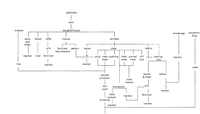


Chapter 2
I Technology Transported; 1788-1840
II Technology Established; 1840-1940
i Meat Preserving: Heat Processing Introduced
ii Horticultural Products: Heat, Sugar and Solar Drying
iii Refrigeration and the Export of Meat
iv Milling and Baking
v Dairy Products
vi Beverages
vii Sugar: Supplying an Ingredient
III The Coming Of Science
IV From Science To Technology: The Post-war Years
V Products And Processes
VI Conclusion
VII Acknowledgements
References
Index
Search
Help
Contact us

Meat Preserving: Heat Processing Introduced (continued)
Ritchie drew on his considerable English and Rumanian experience, and, with Albert Purchas, an engineer of Melbourne, he directed the erection and equipment of his factory. It is to the credit of the engineering infrastructure of Victoria at that time that, apart from the 16 h.p. steam engine, which came from Glasgow, all the equipment was made in Melbourne; the boiler from Enoch Chambers, boiling down vats from Fuller and Co., engineering equipment from Robison Bros., and all the tin working equipment from Otto Bobardt, a Melbourne mechanical engineer who supplied many other meat preservers both in Victoria and in other colonies.The Melbourne Meat Preserving Company produced fresh meat, canned meats, meat extract, fertilizer, tallow, skins, and hides. Nothing was wasted and there was no pollution. It also enjoyed easy access to water transport. In 1870 it was the largest meat preserver in Australia. It employed 251 people and in January that year shipped to London 50,000 tins about 132 tons of meat and 254 tons of tallow. The factory 'was an advanced, integrated operation which would bring no disgrace on the management of a modern meat works'.[25] (See Fig. 1)

Ritchie was a good technologist. He was also an innovator. The brine baths were heated by steam pipes immersed in the brine and there was a temperature drop along them. To overcome this Ritchie simply used parallel pipes to introduce steam from each end. He was credited, too, with the introduction in 1868 of water-cooling of the finished cans to minimize cooking. He also tried to overcome over-cooking by developing a kind of rissole. Chopped meat with spices was oven-dried and canned with a little meat jelly. These cans were then processed for a short time, which varied with the size of the cans, but although the process was successful the resulting product was not accepted by the market. Ritchie's most successful innovation was his modification of an American packing machine. In 1878, when the Australian round tins were being undermined on the British market by American square ones, the Melbourne Meat Preserving Company imported one of the American machines and Ritchie modified it so that it packed four tins per minute instead of ten per hour, a twenty-four-fold increase in productivity.
Tindal in New South Wales and Ritchie in Victoria were the mainsprings in the establishment of Australian meat canning as an on-going industry. In the 1870s particularly there were many imitators, driven on by the perceived opportunities offered by the shortfall in butchers' meat in Britain. In many provincial centres in Victoria, Ballarat, Warrnambool, Ararat, Echuca, for ample, optimistic groups of men, mainly graziers, financed local meat preserving works.[26] Most of them failed within a year or two. One of the more successful eventually was that at Colac, which was established initially to can rabbits. The manager was C. M. Farrington who had been Ritchie's partner in the wine and spirit venture. Ritchie taught Farrington and acted as consultant to the works. After a very shaky start and a financial reorganization the Colac factory, between 1871 and 1886, when it finally closed, canned more than six and a half million rabbits. The technology was, inevitably, that derived from 137 Houndsditch, London.
Organisations in Australian Science at Work - Fuller and Co., Melbourne; Melbourne Meat Preserving Company, Vic.; Robison Bros., Melbourne
People in Bright Sparcs - Bobardt, Otto; Chambers, Enoch; Farrington, Charles Moulden; Purchas, Albert; Ritchie, Samuel Sextus; Tindal, C. G.
 |
Australian Academy of Technological Sciences and Engineering |  |
© 1988 Print Edition pages 81 - 82, Online Edition 2000
Published by Australian Science and Technology Heritage Centre, using the Web Academic Resource Publisher
http://www.austehc.unimelb.edu.au/tia/081.html